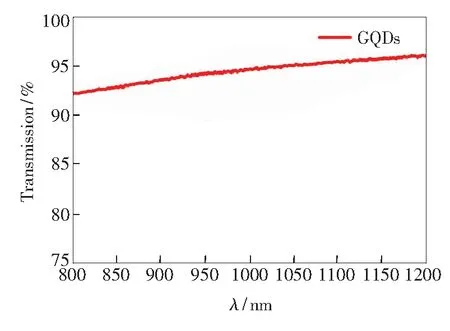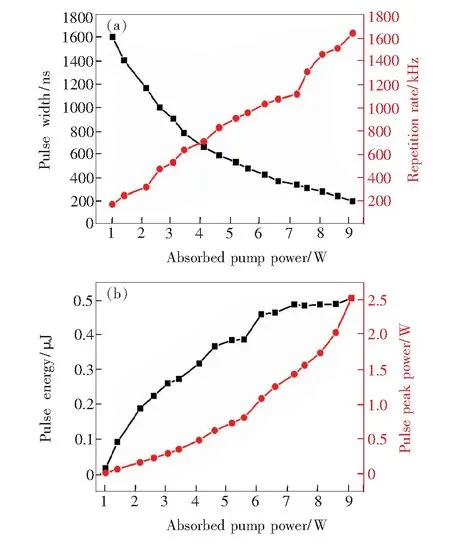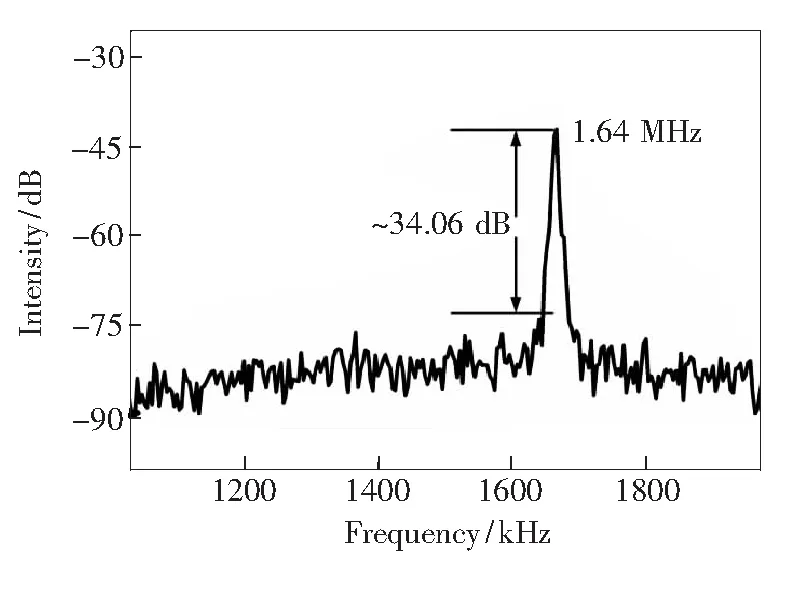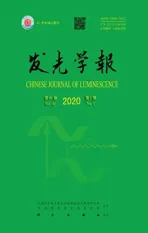Passively Q-switched Nd∶YVO4 Laser Based on Graphene Quantum Dots
2020-01-17DINGRongCHANGJianhuaKONGChunxiaSHIShaohangDAIRui
DING Rong, CHANG Jian-hua,2*, KONG Chun-xia, SHI Shao-hang, DAI Rui
(1. Collaborative Innovation Center of Atmospheric Environment and Equipment Technology, Nanjing University of Information Science & Technology, Nanjing 210044, China;2. Jiangsu Key Laboratory of Meteorological Observation and Information Processing, Nanjing University of Information Science & Technology, Nanjing 210044, China)
Abstract: In this paper, graphene quantum dots (GQDs) saturable absorber (SA) was prepared by hydrothermal method. The optical properties of the GQDs SA was characterized and the modulation depth was calculated to be 6.9%. Using the GQDs SA into diode-end-pumped Nd∶YVO4 laser, a passively Q-switched operation of 1 063.5 nm laser was realized. Pulses as short as 200 ns under a repetition frequency of 1.64 MHz were generated at the absorbed pump power of 9.12 W, implying a pulse energy of 0.51 μJ with the peak power of 2.5 W.
Key words: solid state laser; pulse laser; graphene quantum dots; saturable absorber; passively Q-switched
1 Introduction
All-solid-state passivelyQ-switched lasers are very attractive owing to their numerous applications such as micromachining, laser ranging, remote sensing, microsurgery and nonlinear frequency conversion. These laser systems are significantly compact, simple, and low cost by using saturable absorbers compared with activelyQ-switched lasers. PassiveQswitching of solid-state lasers by use of an intracavity saturable absorber (SA) is a major technique that is widely used for generating giant pulses. According to the report, semiconductor materials such as GaAs[1]and semiconductor saturable absorber mirrors (SESAMs) have been used asQ-switched elements to generate laser pulses[2-4]. Neverthless, the laser pulses generated by GaAs absorbers are relatively unstable[5], while the SESAMs require very complex and costly clean-room-based epitaxial grow processes as well as the working wavelength range is limited and the modulation depth is difficult to adjust[6]. At present, researchers have conducted extensive continuous searches for stable and broadband SAs. Some promising materials that meet these standards are nanomaterials such as carbon nanotubes[7]and graphene[8-12]. Two-dimensional materials of transition metal dichalcogenides(TMDs)[13-14]such as MoS2and WS2, also show great prospects for SA materials[15-19]. However, graphene has the weakness of having a very low modulation depth(typically <1% per layer)[20-21], while the CNT generates high losses due to wide tube diameter to cover wider bandwidth[22]. Due to the large bandgap in the visible region, the performance of TMDs in near infrared and mid infrared regions is limited[23].
In addition to the two-dimensional layered structure, quantum dots (QDs) are another kind of nanomaterials, which exhibit some interesting photoelectric properties due to quantum confinement and edge effect[24-25]. QDs are zero-dimensional materials, which have attracted wide attention in important applications, including SAs[26], laser power limiters, light-emitting diodes, optical switches, sensors[27-29], biological labeling, and solar cells. QDs have a very small particle size, ranging from 1 to 100 nm, and have special chemical processing ability. Due to the strong confinement of excited electrons and holes, QDs show significant differences in electronic and optical properties from bulk semiconductors[30]. One QDs material is graphene quantum dots (GQDs), which is nanomaterials with quasi-zero-dimensional structure. Because their own radius is smaller than Bohr excitation radius, the movement of electrons in the three-dimensional direction of atoms is limited, the quantum localization effect is very significant and it has many unique physical and chemical properties. Compared with other traditional semiconductor quantum dots, GQDs have the following unique properties: they do not contain toxic metal elements such as cadmium and lead, and are environmentally friendly quantum dot materials; they have stable structure, strong acid and alkali resistance, and photobleaching resistance; and their thickness can reach single atom. The transverse dimension of the layer can reach several interconnected benzene ring sizes, but they can maintain high chemical stability. In principle, the bandgap width can be adjusted in the range of 0-5 eV by quantum localization effect and edge effect, so that the wavelength range can be extended from near infrared region to visible region and deep ultraviolet region, thus meeting the requirements of various technologies for material energy gap and characteristic wavelength. Considering the unique characteristics of newly developed GQDs, it would be interesting to investigate the nonlinear optical response of GQDs and to see whether it is suitable for applications of ultrafast photonics for telecommunication band. Bearing this in mind, herein we firstly prepared the GQDs SA by spin-coating method. By using Z-scan technique, it was found that the nonlinear saturable absorption could be observed at optical communication waveband, indicating that the as-prepared GQDs could be used in passivelyQ-switched lasers.
Recently,PMMA-doped CdSe quantum dots were used as saturable absorbers in a passivelyQ-switched laser, producing 0.77 μJ pulses with a pulse width of 3.65 μs in a fiber laser[31]. Then, CsPbBr3perovskite quantum dots saturable absorbers were used in aQ-switched visible laser for the generation of soliton pulse[32]. Applications of Cu2-xSe QDs inQ-switched lasers have also been demonstrated[33]. In this work, we first prepared a GQDs SA and characterized its optical properties. With the prepared GQDs SA, a passivelyQ-switched Nd∶YVO41 063.5 nm laser is presented for the first time. At the incident pump power of 9.12 W, the shortest pulse width of 200 ns was generated at the repetition frequency of about 1.64 MHz, and the corresponding peak pulse power can reach 2.5 W.
2 Fabrication and Characterization of GQDs SA
The GQDs solution used in the experiment was fabricated by hydrothermal method. First, 0.1 mL (with the concentration of 20 mg/mL) GQDs was dispersed into 50 mL toluene, then we stirred the GQDs solution by ultrasound for about 1 h and centrifuged at the speed of 1 500 r/min for 20 min to remove large size sedimentations. After that, the GQDs solution was dripped onto the SiO2substrate, and then rotated the SiO2substrate at low speed to disperse the solution uniformly. Finally, the SiO2substrate was driedviaa heating platform to obtain the GQDs SA.
The resulting fabrication, which display nonlinear absorption and scattering of incident light, is well-characterized by various physical techniques such as using X-ray diffraction (XRD), transmission electron micrographs(TEM) and Raman spectra. The nonlinear optical properties (NLO) of the GQDs were measured employing the Z-scan system with a 10 kHz laser pulse and a pulse duration of 4 ns at 1 064 nm. The XRD patterns of the as-prepared GQDs SA was shown in Fig.1(a). The diffraction pattern of the GQDs SA at 2θ=21.5°, conforms to the graphitic structure[34-35]. The broadness of the diffraction peak states clearly the small size of the GQDs. The Raman scattering spectroscopy in Fig.1(b) shows the D-band at 1 366 cm-1arising from the disorder in sp2hybridized carbon, and the G-band at 1 595 cm-1corresponding to graphitic structures. TEM image in Fig.1(c) obviously reveals the crystalline structure of the nanoparticles. The measured lattice spacing is 0.21 nm, corresponding to the {1100} lattice fringes of graphene.

Fig.1 Characterizations of the GQDs. (a)XRD of the GQDs. (b)Raman scattering spectroscopy of the GQDs. Inset: image of the GQDs solution. (c) TEM image of the GQDs.
As can be seen from Fig.2(a), the normalized Z-scan peak curve of GQDs and the corresponding fitting curve, which indicated a typical SA response with a sharp peak located at the beam focal point. The results demonstrated that the prepared GQDs are provided with obvious saturable absorption effect at 1 064 nm waveband. According to the relationship between laser beam spot size and relative separation, the nonlinear saturable absorption curve could be deduced, as shown in Fig.2(b). Here, the saturation intensity could be calculated as 19.6 MW/cm2and the modulation depth is 6.9%. Therefore, the measurements indicate that the GQDs can be performed as a SA to generate ultrashort pulse generation in lasers. Linear transmission measurement of the GQDs SA (including the SiO2substrate) was also fulfilled by a UV-Vis-NIR spectrophotometer, as shown in Fig.3. The transmissions of the GQDs thin film was around 95.09% at 1 064 nm.

Fig.2 Nonlinear optical response of the as-prepared GQDs. (a)Typical Z scan curve at 1 064 nm. (b)Corresponding nonlinear saturable absorption curve.

Fig.3 Linear transmission measurement of the GQDs
3 Experimental Setup
The experimental setup of the resonantly pumped Nd∶YVO4laser is shown in Fig.4. It was end-pumped by a fiber-coupled laser diode operating at 808 nm with a fiber core diameter of 400 μm and numerical aperture of 0.22. The pump laser was focused on the gain mediumviaa 1∶1 coupling system to a spot radius of about 200 μm. The Nd∶YVO4crystal was 3 mm×3 mm×5 mm in dimension with an Nd-doped concentration of 0.5%. The front facet (S1) of the Nd∶YVO4crystal was antireflective (AR) coated at 808 nm and high-reflection (HR) coated at 1 064 nm. The rear facet (S2) was coated with an AR coating at 1 064 nm to reduce the Fresnel losses. The Nd∶YVO4crystal was wrapped in indium foil and press-fitted into a copper block serving as a heat sink, which was kept at the temperature of 25 ℃. We used GQDs film deposited on the silica sheet as the SA. The transmissions of the output coupler (M1) are 10% for 1 064 nm. According to ABCD array theory, the radii of oscillating light spot on Nd∶YVO4crystal and GQDs SA crystal are calculated to be about 242 μm and 227 μm, separately.

Fig.4 Schematic of passivelyQ-swtiched Nd∶YVO4laser based on the GQDs SA
4 Results and Discussions
Firstly, we study the operation of the continuous wave (CW) Nd∶YVO4laser. The output power was measured by a touch-screen power meter (Thorlabs PM200) connected to the thermal power probe (Thorlabs S401C). The laser runs at the threshold pump power of 0.74 W, the output power is plotted in Fig.5 as a function of the absorbed pump power. At the absorbed pump power of 9.12 W, the maximum average output powers was 1.32 W, with the slope efficiency and the optical-to-optical efficiency of 15.7% and 14.5%, respectively. This indicates that the designed resonator achieves good mode matching. The reason for the low slope efficiency and optical conversion efficiency is that when the pump laser was focused on the gain mediumviaa coupling system, there will be a certain loss, and the laser oscillates in the resonator also inevitably results in loss. At the same time, the transmission of the output coupler (M1) used in our experiment is not optimized because of the limitation of experimental conditions, it will lead to the low slope efficiency and optical conversion efficiency. On inserting the GQDs SA close to the M1, the diode-pumped Nd∶YVO4laser ran into passivelyQ-switched operations. Fig.5 shows the average output power for the output coupler transmittanceT=10% with the absorbed pump power. It is noted from Fig.5 that the average output power increases linearly with the total absorbed pump power. With a careful adjustment to the cavity elements, a stableQ-switched regime was observed as soon as the absorbed pump power reached a threshold condition of 1.03 W. Meanwhile, the maximum average output power is 830 mW, corresponding to an optical-to-optical efficiency of 11.3% and a slope efficiency of 10.2%.

Fig.5 Output power of the CW andQ-switched laserversusthe absorbed pump power
The laser pulse width, repetition frequency and waveform were received by a fast photodiode (Newport Model 818-BB-21) with a rising time of 250 ps and a digital oscilloscope with a bandwidth of 500 MHz (Agilent MSO7052B). Fig.6(a) shows the evolution of pulse repetition rate and pulse width. When the absorbed pump power was increasing from 1.03 to 9.12 W, the pulse width decreased from 1 600 to 200 ns, while the pulse repetition frequency almost linearly increased from 0.263 to 1.640 MHz, implying a pulse energy of 0.51 μJ with the peak power of 2.5 W. The reason that the pulse width decreases with the increase of the absorption pump power is that the density of photons in the cavity increases with the increase of the absorption pump power, the bleaching of saturated absorber becomes faster and theQ-switching time becomes shorter. Fig.7 shows the typical pulse trains and the pulse temporal shapes generated byT=10% at the incident pump power of 9.12 W.

Fig.6 (a)Pulse widths and the repetition ratesversusthe incident pump powers forQ-switched operations. (b)Evolutions of the pulse energy and the pulse peak power with the pump power.
The spectrum of the CW andQ-switched laser were measured by a 0.25 nm resolution optical fiber spectrometer (Seemantech S3000-VIS), as shown in Fig.8. For the optical spectrum of the CW laser, the full width at half maximum (FWHM) bandwidth was 1.2 nm and the central wavelength was 1 063.5 nm. For the optical spectrum of theQ-switched laser, the FWHM bandwidth was approximately 1.6 nm, and the central wavelength was nearly the same as that of CW laser. The spectral intensity ofQ-switched laser was little lower than that of CW laser, which was consistent with the output result shown in Fig.8.

Fig.7 Pulses trains and temporal pulse shapes generated from passivelyQ-switched lasers with the incident pump power of 9.12 W

Fig.8 Laser spectra in CW and GQDs operations
The commercial RF spectrum analyzer (Agilent N9918A) was used to measure the radio frequency (RF) spectrum to verify the stability of theQ-switched laser. As can be seen from Fig.9, the signal-to-noise ratio (SNR) for GQDs reaches up to ~34.06 dB at 1.64 MHz, which proves the stable performance of the GQDsQ-switched laser.

Fig.9 RF spectra of Q-switched pulses for GQDs SA
5 Conclusion
In conclusion, we demonstrated a passivelyQ-switched Nd∶YVO4laser using GQDs as saturable absorber, with a ~830 mW output power and an optical-to-optical conversion efficiency of 11.3%. The laser emitted stable ~200 ns passivelyQ-switched pulses at a repetition rate of 1.64 MHz at 1 063.5 nm, corresponding to the peak power of 2.5 W and single-pulse energy of ~0.51 μJ, separately. The experimental results reveal that the GQDs SA was suitable in 1 064 nm passivelyQ-switched Nd∶YVO4laser.
